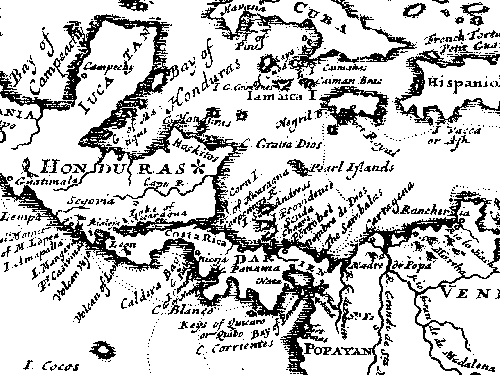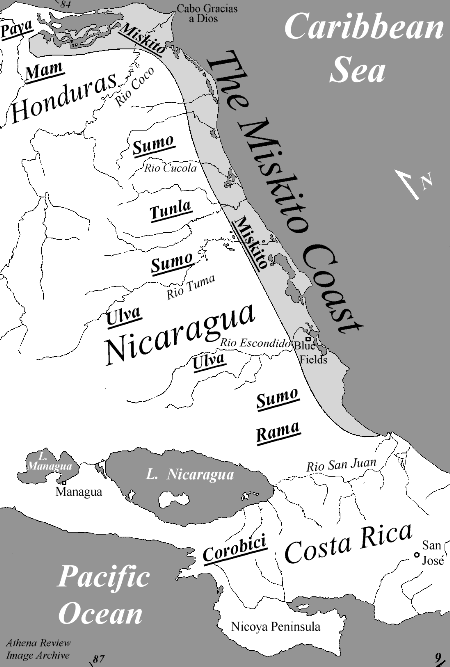| Athena Review Vol.1,
no.2
| | |
The New World Voyages of William Dampier | | | | |
|
William
Dampier (1652-1715), British explorer and sea captain, is one of the
most highly regarded map-makers and navigators of all time. Dampier was
born in Somersetshire, England and went to sea by age 16. Between 1675
and 1678 he became involved with buccaneers along the Spanish Main in
Central America. These adventures, told in his own books, are
corroborated in the writings of two of Dampier's shipmates, Basil
Ringrose (whose journal was included in Esquemeling's Buccaneers of
America, printed in 1685); and the surgeon Lionel Wafer, whose own
account was published in 1699.
 Dampier's most unusual associate, however, was probably Alexander Selkirk, a member of the crew of the 1703 voyage who was
marooned by his own wish on Juan Fernandez Island. Selkirk, whose story
was retold by Daniel Defoe in Robinson Crusoe (1719), was eventually
rescued by Dampier on his last voyage. Dampier's most unusual associate, however, was probably Alexander Selkirk, a member of the crew of the 1703 voyage who was
marooned by his own wish on Juan Fernandez Island. Selkirk, whose story
was retold by Daniel Defoe in Robinson Crusoe (1719), was eventually
rescued by Dampier on his last voyage.
Fig.1: Portrait of William Dampier by Thomas Murray, in London's National Portrait Gallery (Masefield, 1906).
Dampier
led several voyages of mapping and exploration around the world.
Findings from the first expedition, published in 1697 as A New Voyage
Round the World, produced a commision from the English Admiralty in
1699 to explore the South Seas. The results included many new charts of
coastlines and currents around Australia and New Guinea. Dampier
discovered and named New Britain, and also discovered the Archipelago
in Northwest Australia now named for him.
In
his New World voyages, Dampier provides some of the earliest
descriptions of native cultures as well as coastlines, rivers, and
villages. One of his accounts concerns the Miskito Indians, a group of
tribes living along the Caribbean coast who
associated with both traders and pirates.
As described by Dampier in A New Voyage Round the World, in 1681 he and his shipmates, including several Miskito Indians, landed on the south coast of Panama (then called Darien). The Miskito represented a composite group of tribes and
descendents of runaway slaves living along the Caribbean coastline of
Honduras and Nicaragua, a region called the Miskito Coast. Dampier pays high respect to the fishing and harpooning skills of the Miskito, and also provides, in one of the very earliest descriptions of the Miskito (called the Moskito by Dampier), various observations on their social customs and farming methods.
"...When
we had rowed and towed against the Wind all night; we just got about
Cape St. Lorenzo in the morning; and sailed about 4 miles farther to
the Westward, and run into a small Creek within two Keys, or little
Islands, and rowed up to the Head of the Creek, being about a Mile up,
and there we landed May 1681. We got out all our Provision and Cloaths,
and then sunk our Vessel. While we were landing and fixing our Snap
-sacks to march, our Moskito Indians struck a plentiful Dish of Fish,
which we immediately drest, and therewith satisfied our Hunger.
 "
Having made mention of the Moskito Indians, it may not be amiss to
conclude this Chapter with a short account of them. They are tall,
well- made, raw -bon'd, lusty, strong, and nimble of Foot, long
-visaged, lank black Hair, look stern, hard favour'd, and of a dark
Copper- colour Complexion. They are but a small Nation or Family, and
not 100 Men of them in Number, inhabiting on the Main on the
North-side, near Cape Gratia Dios; between Cape Honduras and Nicaragua. "
Having made mention of the Moskito Indians, it may not be amiss to
conclude this Chapter with a short account of them. They are tall,
well- made, raw -bon'd, lusty, strong, and nimble of Foot, long
-visaged, lank black Hair, look stern, hard favour'd, and of a dark
Copper- colour Complexion. They are but a small Nation or Family, and
not 100 Men of them in Number, inhabiting on the Main on the
North-side, near Cape Gratia Dios; between Cape Honduras and Nicaragua.
Fig.2: Map of Central America and the Caribbean by Dampier. The Miskito Coast is marked with a star (Dampier 1697, A New Voyage Round the World).
"They
are very ingenious at throwing the Lance, Fisgig, (1) Harpoon, or any
manner of Dart, being bred to it from their Infancy; for the Children
imitating their Parents, never go abroad without a Lance in their
Hands, which they throw at any Object, till use hath made them masters
of the Art. Then they learn to put by a Lance, Arrow, or Dart: The
manner is thus. Two boys stand at a small distance, and dart a blunt
stick at one another; each of them holding a small stick in his right
hand, with which he strikes away that which was darted at him. As they
grow in years they become more dexterous and courageous, and then they
will stand a fair mark, to any one that will shoot Arrows at them;
which they will put by with a very small stick, no bigger than the Rod
(2) of a Fowling-piece; and when they are grown to be Men, they will
guard themselves from Arrows, tho they come very thick at them,
provided two do not happen to come at once. They have extraordinary
good Eyes, and will discry a Sail at Sea farther, and see any thing,
better than we.
"Their chiefest employment in their own
Country is to strike Fish, Turtle or Manatee, the manner of which I
describe elsewhere, Chap. 3. For this they are esteemed and coveted by
all Privateers; for one or two of them in a Ship, will maintain 100
Men: So that when we careen our Ships, we choose commonly such places,
where there is plenty of Turtle or Manatee for these Moskito Men to
strike; and it is very rare to find Privateers destitute of one or more
of them, when the Commander, or most of the Men are English; but they
do not love the French, and the Spaniards they hate mortally. When they
come among Privateers they get the use of Guns, and prove very good
marks Men; they behave themselves very bold in fight, and never seem to
flinch nor hang back; for they think that the white Men with whom they
are, know better than they do when it is best to fight, and let the
disadvantage of their party be never so great, they will never yield
nor give back while any of their party stand.
"I could
never perceive any Religion nor any Ceremonies, or superstitious
Observations among them, being ready to imitate us in whatsoever they
saw us do at any time. Only they seem to fear the Devil, whom they call
Wallesaw; and they say he often appears to some among them, whom our
Men commonly call their Priest, when they desire to speak with him on
urgent business; but the rest know not any thing of him, nor how he
appears, otherwise than as these Priests tell them. Yet they all say
they must not anger him, for then he will beat them, and that sometimes
he carries away these their Priests. Thus much I have heard from some
of them who speak good English.
" They marry but one Wife,
with whom they live till death separates them. At their first coming
together, the Man makes a very small Plantation, (3) for there is Land
enough, and they may choose what spot they please. They delight to
settle near the Sea, or by some River, for the sake of striking Fish,
their beloved employment.
 " Far within land there are other
Indians, with whom they are always at War [4]. After the Man hath
cleared a spot of Land, and hath planted it, he seldom minds it
afterward, but leaves the managing of it to his Wife, and he goes out a
striking. Sometimes he seeks only for Fish, at other times for Turtle,
or Manatee, and whatever he gets he brings home to his Wife, and never
stirs out to seek for more till it is all eaten. When hunger begins to
bite, he either takes his Canoa and seeks for more game at Sea, or
walks out into the Woods and hunts about for Peccary, [5] Waree, (6)
each a sort of wild Hogs, or Deer; and seldom returns empty handed, nor
seeks for any more so long as any of it lasts. " Far within land there are other
Indians, with whom they are always at War [4]. After the Man hath
cleared a spot of Land, and hath planted it, he seldom minds it
afterward, but leaves the managing of it to his Wife, and he goes out a
striking. Sometimes he seeks only for Fish, at other times for Turtle,
or Manatee, and whatever he gets he brings home to his Wife, and never
stirs out to seek for more till it is all eaten. When hunger begins to
bite, he either takes his Canoa and seeks for more game at Sea, or
walks out into the Woods and hunts about for Peccary, [5] Waree, (6)
each a sort of wild Hogs, or Deer; and seldom returns empty handed, nor
seeks for any more so long as any of it lasts.
Fig.3: The Miskito Coast, showing tribal regions (Athena Review, after BAE Bull 143, vol.4, map 5).
"
Their Plantations are so small, that they cannot subsist with what they
produce: for their largest Plantations have not above 20 or 30 Plantain
Trees, (7) a bed of Yams (8) and Potatoes, (9) a bush of Indian Pepper
(10), and a small spot of Pine-apples(11) ; which last fruit is a main
thing they delight in, for with these they make a sort of drink which
our men call Pine-drink, much esteemed by these Moskito's, and to which
they invite each other to be merry, providing Fish and Flesh also.
Whoever of them makes of this Liquor treats his Neighbours, making a
little Canoa full at a time, and so enough to make them all drunk; and
it is seldom that such Feasts are made, but the party that makes them
hath some design, either to be revenged for some injury done him, or to
debate of such differences as have happened between him and his
Neighbours, and to examine into the truth of such matters. Yet before
they are warmed with drink, they never speak one word of their
grievances: and the women,. who commonly know their Husbands designs,
prevent them from doing any injury to each other by hiding their
Lances, Harpoons, Bows and Arrows, or any other weapon that they have.
"
These Moskito's are in general very civil and kind to the English, of
whom they receive a great deal of respect, both when they are aboard
their Ships, and also ashore either in Jamaica, or elsewhere, whither
they often come with the Seamen. We always humour them, letting them go
any whither as they will, and return to their country in any Vessel
bound that way, if they please. They will have the management of
themselves in their striking, and will go in their own little Canoa,
which our men could not go in without danger of oversetting; nor will
they then let any white man come in their Canoa, but will go a striking
in it just as they please: All which we allow them. For should we cross
them, tho' they should see shoals of Fish, or Turtle, or the like, they
will purposely strike their Harpoons and Turtle-irons aside, or so
glance them as to kill nothing. They have no form of Government among
them, and acknowledge the King of England for their sovereign: They
learn our language, and take the Governour of Jamaica to be one of the
greatest princes in the world..."
Notes: (based partly on Masefield's 1906 edition)
1. Fisgig, fishgig, or visgee, now generally called the grains, a harpoon with three or more barbed heads.
2. The ramrod.
3.
Lionel Wafer (the surgeon on this voyage, who published his own account
in 1699) tells us that the plantation was cleared for the newly married
couple by the men of the Mosquito tribe.
4. Such outside tribes
were collectively called the Sumo by the Miskito (see fig.2). A
typical Miskito village held between 100 and 500 inhabitants. Sumo
villages were apparently much smaller. (For more information on the
Sumo and Miskito cultures, see Bureau of American Ethnology (BAE), Bull.143,v4 [1948], pp. 219-229.)
5. Peccary (Dicotyles torquatus). A gregarious wild hog. "'Tis black, and has little short legs, yet is pretty nimble."
6. Warree (Dicotyles labiatus).
"A very good sort of a wild beast, which is much like unto our English
Hog ." It has tusks and bristles like the European wild boar. It is
much more savage than the peccary.
7. Plantain (Musa sapientum). A large variety of banana, originally imported from the Old World.
8.
Yam (Discorea alata), imported from Africa. The word comes via
Portuguese inhame, probably from Bantu nyama ("meat") or Bambara nyana
("wild yam").
9. Sweet potato (Ipomoea batatas), a New World domesticate originally from the Andean region.
10. Indian Pepper: any of several species of Capsicum , all of which are New World domesticates.
11. Pineapple (Ananas comosus). Another New World domesticate.
.
|
|
| Main
index of Athena Review
Copyright © 2023 Rust Family Foundation
(All Rights Reserved). | | |
.
|